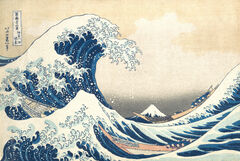Ukiyo-e is a genre of Japanese art that flourished from the 17th through the 19th centuries. Its artists produced woodblock prints and paintings. The prints were notable for being difficult to initially produce as the wooden printing blocks had to be carefully carved, but these block could then be used to print hundreds, even thousands, of prints.
History[]

The Hikone screen may be the oldest surviving ukiyo-e work, dating to c. 1624–1644
The roots of ukiyo-e can be traced back to the earlier art form called Yamato-e, which depicted scenes from Japanese history and mythology. However, ukiyo-e emerged as a distinct art style in the 17th century, reflecting the flourishing urban culture of Edo (present-day Tokyo) and capturing the essence of the pleasure districts, theaters, festivals, landscapes, and famous personalities of the time.
During the 18th and 19th centuries, ukiyo-e prints gained immense popularity, becoming a significant part of Japanese visual culture. They were collected by people from various social classes, from commoners to samurai, and served as a form of entertainment, education, and even political commentary.
Despite the decline of the ukiyo-e tradition in the late 19th century with the advent of modernization and the rise of photography, its artistic legacy continues to inspire and fascinate people around the world. Today, ukiyo-e prints are treasured artworks, admired for their intricate details, vibrant colors, and their portrayal of a bygone era in Japanese history.
Shin-hanga[]
Through the 19th and 20th centuries, Ukiyo-e was revitalized through the movement of Shin-hanga. Shin-hanga was inspired by European art and incorporated these new techniques into traditional Ukiyo-e. The themes of Shin-hanga remained the same and it featured the same subjects as Ukiyo-e. One of the most prolific paintmakers of the period was Hasui Kawase, who made primarily landscapes.[1]
Sousaku-hanga[]
At the same time as the Shin-hanga movement, a new movement named sousaku-hanga (創作版画, or 'creative prints'), made famous by artists such as Koshiro Onchi, proclaimed self-expression and individuality. Unlike Shin-hanga, it was drastically different from traditional Ukiyo-e. Printmaking was traditionally a collaborative system, but sousaku-hanga artists opposed this and did the drawing, carving, and printing all on their own. Sousaku-hanga prints are distinct because of their more modernist qualities like abstraction and personal expression.[2]
Visuals[]
Ukiyo-e displayed oblique projection, asymmetry, flat plane, and abstract color.
The typical subjects were female beauties; kabuki actors and sumo wrestlers; scenes from history and folk tales; travel scenes and landscapes; flora and fauna; and erotica (called Shunga). The women depicted were most often courtesans and geisha at leisure, and promoted the entertainments to be found in the pleasure districts.
Influence[]

Hokusai's The Great Wave off Kanagawa, 1831
The most famous artist was Hokusai, who created the iconic The Great Wave off Kanagawa in 1831. The Great Wave is still very popular in modern culture and is seen multiple modern aesthetics, such as Vaporwave.[3]
After the re-opening of Japan in the 19th century, Ukiyo-e spread to Europe and started a craze called Japonisme, since it was so unique and different from the European paintings of the period. Ukiyo-e influenced various western art movements and artists of the time, especially the Post-Impressionist Vincent van Gogh, who termed this influence on him "Japonaiserie".
Ukiyo-e art is common to see on t-shirt designs from brands such as UNIQLO. This is partly because Ukiyo-e art is in the public domain and can be used freely by anyone.
Gallery[]
External Links[]
References[]
- ↑ Brown, K. and Goodall-Cristante, H.
- ↑ Wikipedia:Sōsaku-hanga
- ↑ CoitoCG (N/A). Vaporwave Aesthetic Great Wave Off Kanagawa Retro Sunset. Redbubble. Retrieved June 9, 2023. Archived.





